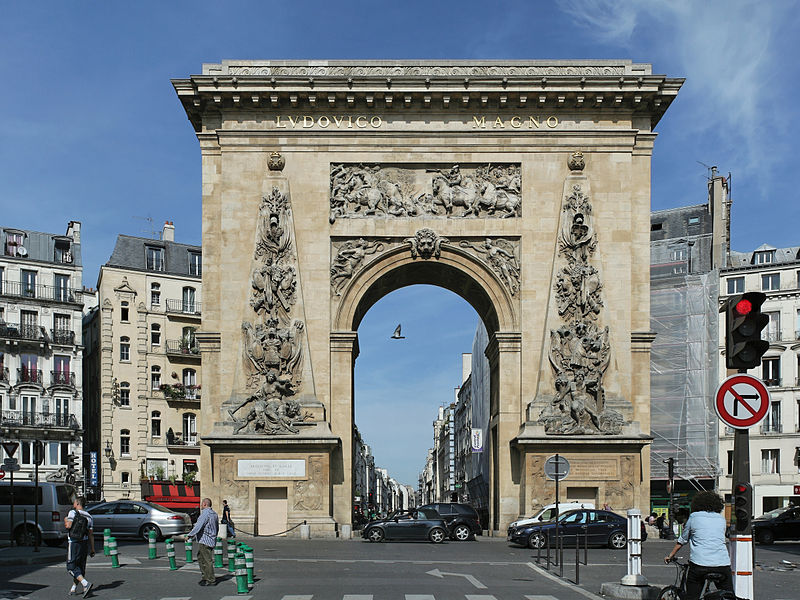<Back to Index>
- Civil Engineer and Military Architect Nicolas - François Blondel, 1618
PAGE SPONSOR

Nicolas-François Blondel (possibly Ribemont, 15 June 1618 - Paris, 21 January 1686) was a soldier, engineer of fortifications, diplomat, civil engineer and military architect, called "the Great Blondel", to distinguish him in a dynasty of French architects. He is remembered for his Cours d'architecture which remained a central text for over a century. His precepts placed him in opposition with Claude Perrault in the larger culture war known under the heading Querelle des anciens et des modernes. If François Blondel was not the most highly reputed among the académiciens of his day, his were the writings that most generally circulated among the general public, the Cours de Mathématiques, the Art de jetter les Bombes, the Nouvelle manière de fortifier les places and, above all his Cours d'Architecture.
He was well educated in languages as a youth, and
participated for a time in the Thirty Years' War. In 1640
the Cardinal de Richelieu
entrusted him with diplomatic missions in Portugal, Spain
and Italy, which gave him an opportunity to study at first
hand the fortification systems of those nations.
Richelieu named him sub-lieutenant of one of his galleys, La Cardinale, aboard which he participated in the attack on the port of Tarragona and served for a time as governor at Palamos. In 1647 Blondel commanded the artillery of the naval expedition against the Spanish at Naples. With the peace he finished his military career with the brevet of maréchal des camps (26 November 1652).
He tutored the son of the Secretary of State for foreign affairs, Loménie de Brienne, with whom he made the Grand Tour: Langres — Besançon — Basel — Alsace (Brisach) — Strasbourg (where he inspected the mechanism of the famous clock) — Philippsburg — Mannheim — Mayence — The Hague — Hamburg — Lübeck — Kiel — Denmark — Sweden (Stockholm, Uppsala) — Finland — Estonia (Riga) — Königsberg — Dantzig — Cracow — Pressburg — Vienna — Prague — Vence — Rome — Florence — Toulon. His travels would stand him in good stead when he came to compile his Cours d'Architecture. During the 1660s Blondel made a second tour with a son of Jean Baptiste Colbert, of which the itinerary is less known.
In 1656, Blondel was named reader in Mathematics and Fortification at the Collège de France, where his place was filled during his numerous absences by the atronomer Picard. From 1662 to 1668, Blondel exercised the functions of Syndic of the College.
In the years 1657 to 1663 Mazarin sent him on diplomatic missions in Italy, Egypt, Greece, Turkey, Germany, Poland, Moscow (where he regretted not having seen the fortifications at Kazan against the Tatars, and found that the maritime defenses were in the Dutch manner), Prussia, Livonia (with the Swedish fortifications of Riga), and Lithuania. In the course of his travels he encountered Paul Wurz, occasioning the correspondence that resulted in Blondel' s first publication. a discussion of trajectories in which he (incorrectly) set himself against writings of Galileo. Some of these questions were taken up again in 1673, when he published his Résolution des quatre principaux problèmes d'Architecture.
In 1659, on a voyage to Constantinople he designed one of the aqueducts of Sinan with three superposed orders of architecture, "qui, par sa grandeur, sa hauteur & la magnificence de sa structure, ne cede en rien à celuy du Pont du Gard." That same year he was posted as diplomatic resident to Copenhagen, and post he filled until 1663, when he was recalled to France to become a conseiller d'État.
The following year, 1664, Colbert named him Ingénieur du Roy pour la Marine, which occasioned his supervision of harbor fortifications in Normandy (Cherbourg, Le Havre), in Brittany and in the Antillies (Martinique, Guadeloupe, Saint - Domingue), where he witnessed at first hand the prodigious effects of a hurricane at the island of Saint - Christophe, and where he found the materials for numerous memoires presented to the Académie des Sciences.
Quatremère de Quincy reported that Blondel's talents for architecture were first tested in 1665, in building the royal ropewalk at Rochefort, Blondel was put in charge of constructing the Roman bridge at Saintes.
In 1669, Blondel was admitted to the Académie des Sciences, as an associate geometre. That year, in the course of a trip to London in the company of Jean - Baptiste du Hamel, secretary of the Académie, he witnessed an unsuccessful blood transfusion effected by the Royal Society in hopes of curing a madman, with the thought that the human passions were transmitted in the blood.
That same year he was commissioned with urbanization projects for the embellishment of Paris, notably the reconstruction of the Porte Saint - Denis and the Porte Saint - Bernard, and the plan for the city's expansion, which he accomplished with the collaboration of the architect Pierre Bullet.
On 31 December 1671, the King named Blondel Director and Professor of the Académie d'architecture.
In 1673, Blondel was appointed professor of mathematics to the Grand Dauphin; if the royal pupil was of mediocre talent, the project resulted in Blondel's Cours de Mathématiques (1683).
From 1670 until his death in 1686, Blondel was wholly occupied in professional matters and teaching. He collaborated on the dictionaries of Antoine Furetière, of Adrien Auzout for mathematics and Giovanni Alfonso Borelli for astronomy.